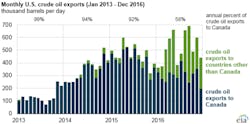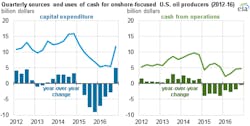Maryland bans hydraulic fracturing
Maryland became the second state in the nation to ban hydraulic fracturing behind New York, which established a similar ban in 2015. Gov. Larry Hogan made good on his promise in March when he announced he would support a fracking ban, saying the potential risks "simply outweigh any benefits."
Maryland does not currently host any hydraulic fracturing sites, but the drilling industry has been hungry to tap into the state’s Marcellus Shale formation. Anti-fracking advocates called the ban a victory for the environment as well as public health.
Total US energy production fell in 2016
U.S. primary energy production in 2016 fell 4 percent from the previous year’s level to 84.1 quadrillion British thermal units (Btu). It was the first annual decline in U.S. energy production since 2009, according to the U.S. Energy Information Administration (EIA).
Graphic courtesy of the EIA
US crude oil exports increased in 2016
U.S. crude oil exports for 2016 jumped 12 percent over the previous year with an average 520,000 barrels per day (b/d), according to the EIA. This 55,000 b/d increase occurred despite a year-over-year decline in domestic crude oil production. And while oil exports have increased, U.S. crude oil growth has slowed significantly since 2013 to 2015, when annual U.S. crude oil production grew rapidly.
Heating season spot prices in 2016-17 averaged 52 percent higher than 2015-16
U.S. benchmark natural gas spot prices at the Henry Hub averaged 52 percent higher in 2016-17 than prices during the same period during 2015-16, according to the EIA. Henry Hub spot prices began the season closer to the previous year’s levels, around $2.00-$2.50 per million British thermal unit (MMBtu), and closed out the year with an average of $3.01/MMBtu.
McIlvaine Company report forecasts IIoT & remote O&M market growth
The oil and gas market opportunity for Industrial Internet of Things (IIoT) & remote operations and maintenance (O&M) will rise to $168 billion in 2030, according to the McIlvaine Company in its latest report, N031 Industrial IOT and Remote O&M. The continually updated report forecasts the IIoT opportunity through 2030 and provides analyses to help suppliers make and adjust their plans to address this opportunity. The detailed coverage of individual industries, products, services, technology and regions provides the specificity needed for planning purposes.
US natural gas storage capacity increased in 2016
Underground natural gas storage capacity in the Lower 48 states changed by moderately small increments in the past three years, compared to the changes in 2012 and 2013, according to the EIA. Long-term trends such as higher levels of natural gas production, the proximity of production to consuming markets in the Northeast and Midwest, and the lower price premium for natural gas during the winter likely contributed to the relatively small change in natural gas storage capacity.
Graphic courtesy of the EIA
US oil producers increased investment in fourth quarter 2016
The largest year-over-year increase for any quarter in the capital expenditures for 44 U.S. onshore-focused oil production companies since 2012 was registered between the fourth quarter of 2016 and the fourth quarter of 2015, according to the EIA. Capital expenditures for those sites increased 72 percent to $4.9 billion between the fourth quarter of 2016 and the fourth quarter of 2015.
More Chinese crude oil imports coming from non-OPEC countries
China increased the share of its crude oil imports from countries outside the Organization of the Petroleum Exporting Countries (OPEC) in 2016. As the world’s largest crude oil net importer at 7.6 million b/d in 2016, 57 percent of its crude oil came from OPEC countries, led by Saudi Arabia (13 percent), Angola (11 percent), Iraq (10 percent), and Iran (8 percent). Non-OPEC supplies included Russia 14 percent), Oman (9 percent) and Brazil (5 percent).
Increase in rail shipments of propane, butane offsets drop in production
Total production of liquefied petroleum gas (LPG) increased to 2.1 million b/d in 2016, according to the EIA. Production of propane and butane, or LPG, increased in all regions of the country except for the West Coast, where production has dropped since 2010, caused in part by declining refinery production.




